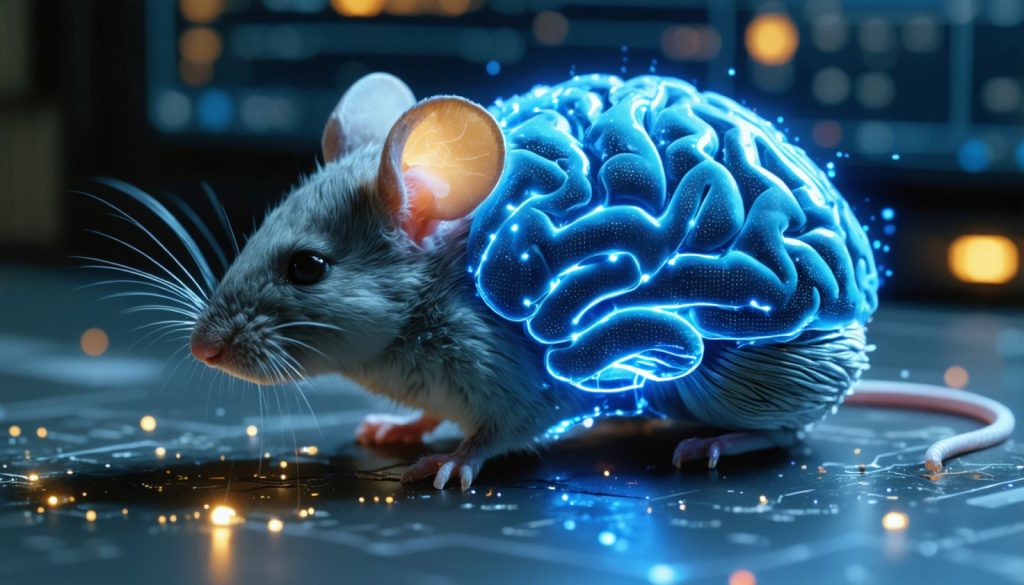
- The study maps 84,000 neurons and 500 million synapses in a mouse brain using cutting-edge technology, creating the most intricate brain map to date.
- A high-powered laser microscope captures cerebral activity as the mouse watches films, enabling researchers to visualize neural connections.
- The brain was sliced into 25,000 microfilms, resulting in nearly 100 million images assembled into a neural mosaic with the aid of artificial intelligence.
- This breakthrough has implications for understanding and treating brain disorders like Alzheimer’s and autism, akin to the Human Genome Project’s impact.
- Funded by NIH’s BRAIN Initiative, the MICrONS consortium, and IARPA, the research invites global collaboration and aims to eventually map an entire mouse brain.
- The study underscores the beauty and complexity of the brain, promising transformative insights into cognition and neural pathways.
A small mouse, flickering in a newly darkened lab room, sits enthralled by the dazzling dance of sci-fi films, a veritable cosmos projected just for its eyes. Yet, in a striking scientific breakthrough, this pint-sized spectator now finds itself in the spotlight at the heart of unveiling the most intricate functional brain map ever crafted.
Harnessing modern alchemy, researchers have mapped the neural landscape of 84,000 neurons interwoven by 500 million synapses, using a fragment of the mouse’s mind scarcely larger than a poppy seed. Picture the neural constellations—tiny filaments weaving a vast tapestry of electric whispers coursing through a three-dimensional expanse, a brain network illuminated with kaleidoscopic vibrancy.
The journey begins in the visual cortex of this extraordinary lab mouse, genetically imbued with neurons that shine like dimming stars when active. As it watches scenes from nature to high-octane science fiction, a high-powered laser microscope captures the interplay of light within its brain—a cerebral symphony of activity.
Slicing this brain into 25,000 ultra-thin microfilms, the team at the Allen Institute for Brain Science in Seattle embarked upon an enigmatic odyssey. Electron microscopes peered deep, amassing nearly 100 million images, each an intricate tile in this neural mosaic.
Artificial intelligence then stepped onto the stage, tracing these connections with the precision of a surgeon. The threads, if unfurled, would stretch beyond three miles—aptly comparing this mapping endeavor to the monumental Human Genome Project. Such a detailed cartography promises to transform how maladies of the mind—such as Alzheimer’s or autism—are understood and treated.
The implications are nothing short of revolutionary. This palette of colors and connections offers neuroscience a roadmap: a chance not just to test old hypotheses but to craft new questions, inspiring future advances as illuminating as the neurons made to glow.
Passionately praised by the global community, this dataset becomes more than a collection of numbers and images; it is an open invitation to delve into the complexity of the brain. Funded through collaborative efforts, including the NIH’s BRAIN Initiative and IARPA, the MICrONS consortium aims even higher—toward mapping an entire mouse brain.
This moment—where a mouse becomes a muse—is emblematic of the delicate beauty and complexity housed within the skull. It is a reminder of how profound discoveries often spring from the simplest curiosities: a mouse, a movie, and a light illuminating pathways otherwise hidden. As science inches closer to unraveling the brain’s mysteries, this luminous venture stands as a beacon of progress, guiding us toward a future where the shadowy workings of cognition might one day be fully understood.
Revolutionary Brain Mapping: The Mouse at the Heart of Neuroscience’s Future
Understanding the Landmark Study
Recent advances in neuroscience have resulted from groundbreaking research by the Allen Institute for Brain Science, employing a novel approach to map the neural landscape of a mouse’s brain. By visualizing 84,000 neurons connected through 500 million synapses—using the brain fragment as small as a poppy seed—researchers have set a new standard in neural mapping, reminiscent of the monumental Human Genome Project.
Key Insights and Impacts
– Technological Breakthroughs: Utilizing high-powered laser microscopes and electron microscopes, the team captured nearly 100 million images, revealing the vibrant network of neural connections. Artificial intelligence played a critical role in tracing these connections, highlighting the interplay between technology and neuroscience.
– Potential for Treating Neurological Disorders: This detailed brain map holds promise for advancements in understanding and treating complex mental health conditions like Alzheimer’s disease and autism. With this neural roadmap, researchers can explore intricate brain functions and malfunctions with unprecedented detail.
– Collaborative Efforts and Funding: The research was funded by initiatives like the NIH’s BRAIN Initiative and gaining support from the MICrONS consortium, emphasizing the global importance and collaborative nature of this endeavor. Such partnerships are vital for pushing the boundaries of what’s possible in brain research.
Exploring Future Possibilities
– Life Hacks for Students and Professionals: Neuroscience students and researchers can harness this dataset to explore brain function more deeply, generating new hypotheses and research projects. This could lead to innovative therapies and diagnostic tools.
– Market Forecasts & Industry Trends: As technology continues to advance, brain-mapping methods will likely influence industries focused on personalized medicine, artificial intelligence, and even cognitive computing.
– Pros and Cons Overview: The sophistication of this research provides a wealth of knowledge, but challenges remain, such as translating these findings from animal models to humans and addressing ethical considerations in neural manipulation.
Common Questions and Expert Responses
– Why is this research significant?
The intricacy of the brain mapping allows for a deeper understanding of brain function and structure, offering insights into the workings of the mammalian brain that were previously unattainable.
– How can this information be used in treating diseases?
By understanding the neural network, scientists can better target treatments for neurological disorders, potentially leading to more effective therapies and prevention strategies.
– What are the limitations of this study?
While the data is invaluable, the translation of these findings to potential treatments for humans requires further research and testing, including ethical considerations.
Actionable Tips and Recommendations
– For Researchers: Dive into the dataset and explore new research avenues, utilizing AI to track complex neural interactions.
– For Educators: Incorporate recent findings into curricula to excite and engage students with cutting-edge science.
– For Healthcare Professionals: Stay updated with the latest research to understand emerging diagnostic tools and treatments.
Conclusion
This revolutionary brain-mapping project is opening new doors for neuroscience. By building on this wealth of knowledge, researchers are poised to make significant strides in understanding and addressing neurological disorders. Embrace this new frontier of brain science as an opportunity to illuminate the mysteries of cognition and improve human health globally.
For more groundbreaking innovations, visit the Allen Institute and NIH.



